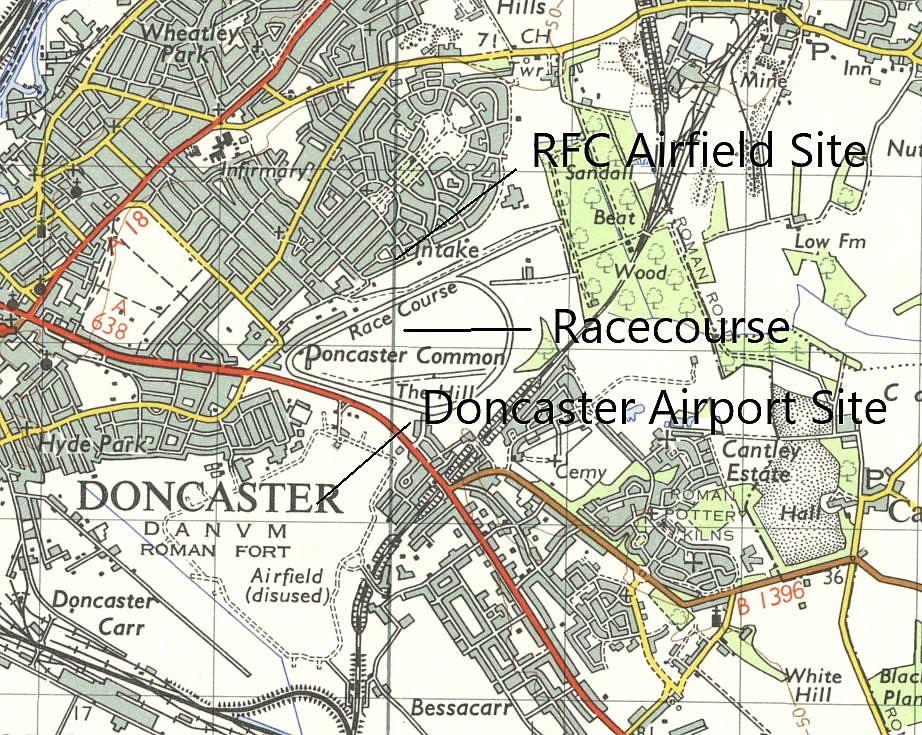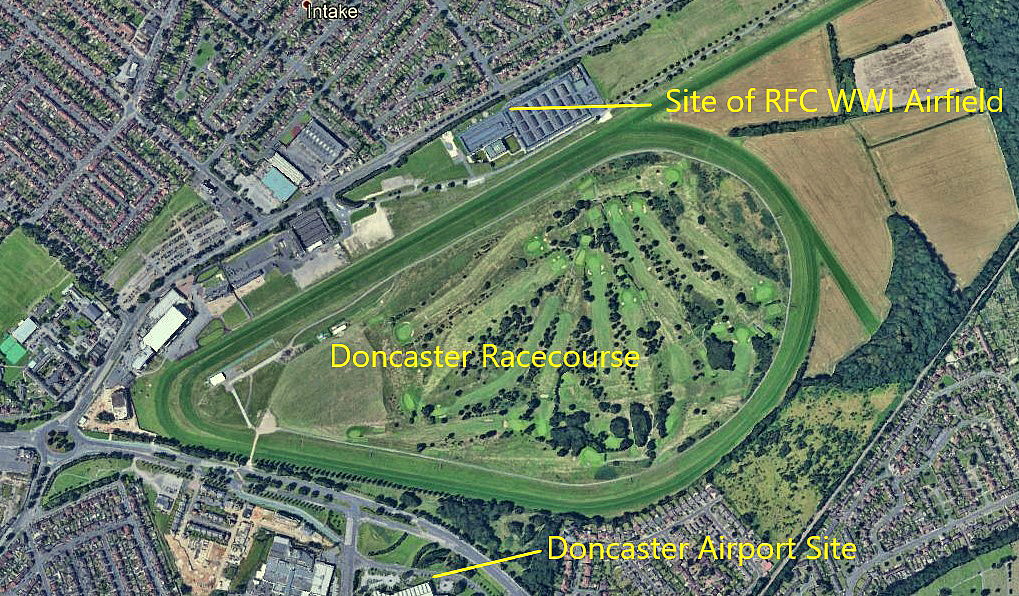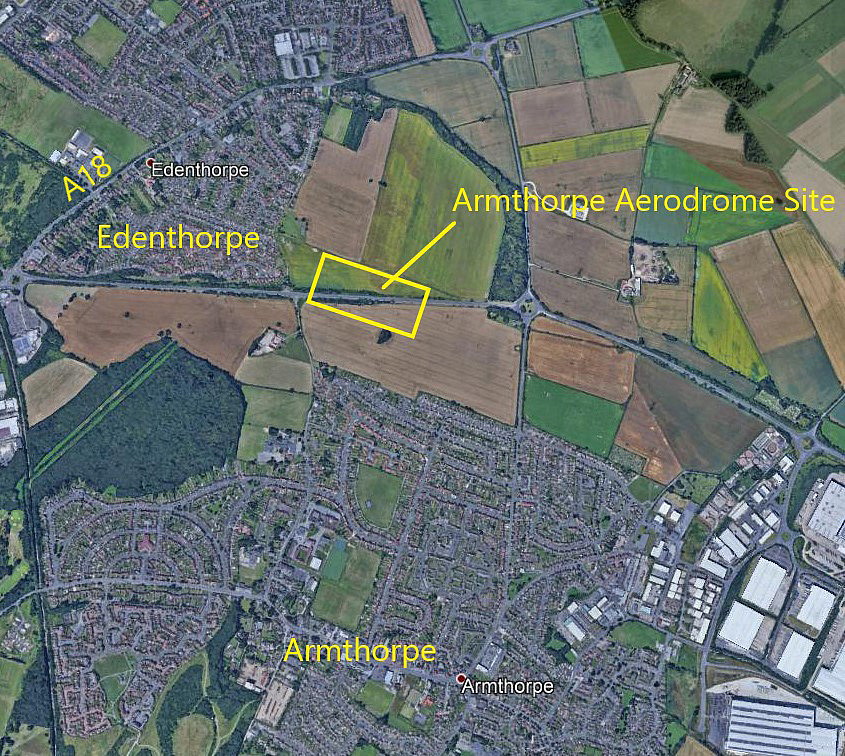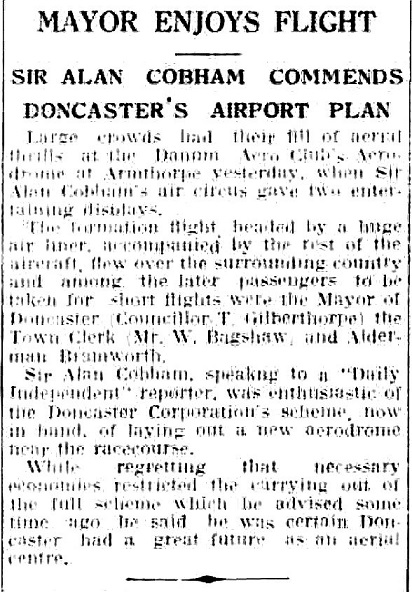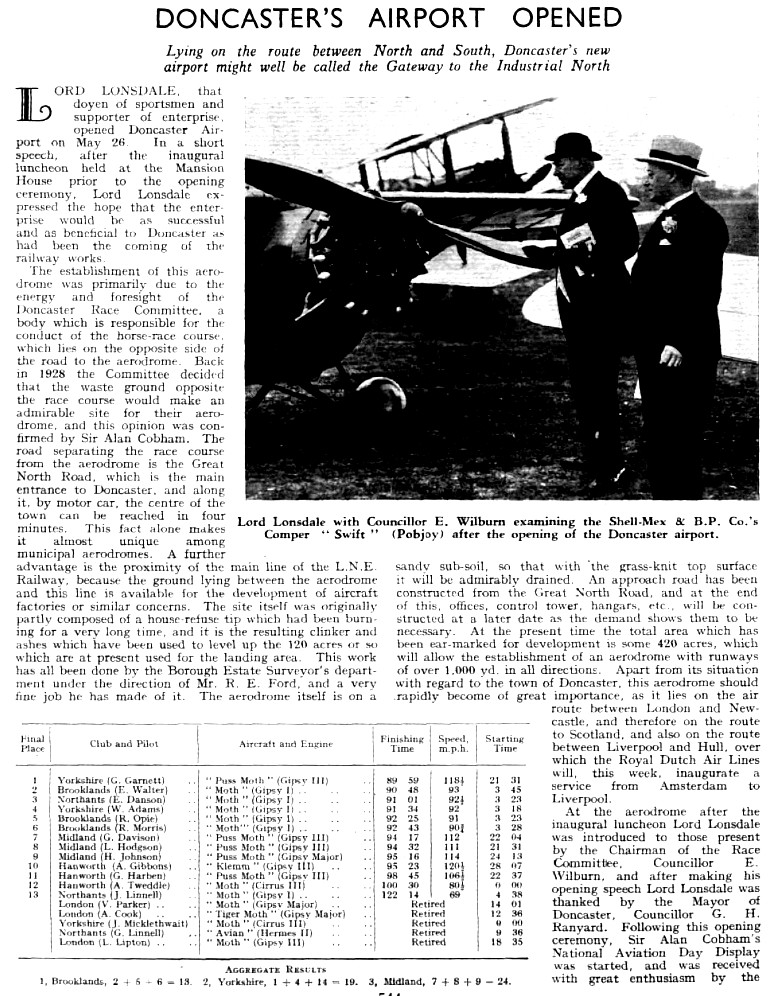Doncaster flying sites
Note: This map shows the position of Doncaster airport.
DONCASTER see also GREEN HOUSE
DONCASTER RACECOURSE: See seperate entry for another important aspect of early aviation history
DONCASTER: Military aerodrome
Military users: RFC/RAF 1916 to 1919
Note: The two maps and the aerial photo were kindly provided by Mr Michael T Holder
15 Reserve Sqdn, 46 Reserve Sqdn.
41 & 49 Sqdns. 82 Sqdn (Armstrong Whitworth FK.8)
Training Squadron Station & (1917) No.47 Training Depot Station
Location: Just to the N of the racecourse, 1.5 miles from Doncaster railway station.
Period of operation: 1916 to 1919
Site area: 248 acres 1006x100(?) grass
NOTES: Initially it appears, the RFC aircraft were based on the racecourse. But, a purpose built airfield was being constructed just to the north with three 'Belfast' hangars
SIR ALAN COBHAM ARRIVES AT THE RACECOURSE
On the 25th July 1929, Sir Alan Cobham flew into the racecourse at Doncaster, and damaged the undercarriage. The why or how seems unknown (?), but it did delay his Municipal Aerodrome Campaign by a day or so. This tour was originally planned to visit 107 venues in mainland Britain, two in Wales, eight in Scotand and the rest in England. The aircraft he mostly used was the ten-seater DH61 'Giant Moth' G-AAEV named 'Youth of Britain'. and in the end with a couple of crashes along the way, he still managed to visit about 95 vemues. Quite a remarkable achievement.
A MICHAEL T HOLDER GALLERY
Note: The two newspaper pictures, (above and below), were both published in the Yorkshire Post and Leeds Intelligencer on the 26th July 1929. The third item is an article published in the Sheffield Daily Independent, also on the 26th July 1929.
Note: The sixth item, a newspaper piece, was published in the Sheffield Daily Telegraph on the 27th July 1929.
It was Cobham's normal practice, after arriving, generally around 11AM, to take the local dignitaries for a flight or two around the local area. This being followed by a slap up luncheon, generally at the town hall when he would extol the numerous benefits of having a municipal aerodrome/airport. He would then take around forty or fifty sponsored school children, ten at a time, for local flights. The then anonymous donor paying for these we now know was Lord Wakefield of Castrol Oil fame. Cobham would then offer flights to the fare paying public until dusk. The revenue earnt no doubt off-setting the costs of the Tour.
So, that relatively minor landing accident, would have been quite a set-back in several ways. However, it appears that before arriving he made a quick survey of the intended airport site, and was well satisfied with the location. Just how much Cobham's visit influenced the decision to construct the airport, is not known - but presumably it must have helped.
DONCASTER - ARMTHORPE
Opened in 1932, this aerodrome appears to have been fairly short lived, it being largely superseded by the larger municipal aerodrome/airport opening in 1934 and situated to the south.
A MICHAEL T HOLDER GALLERY
Note: The second item, a short mention in Flight magazine, was published on the 3rd June 1932:
Note: The sixth item was published in the Sheffield Independent on the 9th June 1933.
DONCASTER: Regional airport, military aerodrome during WW2 ,(?), and later civil airfield
A MICHAEL T HOLDER GALLERY
Note: The opening ceremony article was published in Flight magazine on the 31st May.
Civil gliding site then aerodrome up till the 1980s at least?
At one point after WW2 operated as SOUTH YORKSHIRE AIRPORT (Doncaster) Ltd
Note: This picture was obtained from Google Earth ©
As can be seen, no evidence of this site remains. Which, generally speaking, is quite unusual in the UK.
Military users:
Between the wars: 1938 – Royal Auxiliary Air Force
616 Sqdn (Hawker Hinds, Gloster Gauntlets, Fairey Battles in January 1939 and Spitfire Mk.1s in October 1939. Then moved to RAF LECONFIELD)
WW2: RAF Transport Command 44 Group
271 Sqdn (In 1943 for example the main strength being; Handley Page Harrows, a few Airspeed Oxfords, a Miles Whitney Straight, a DH89A Dominie, a Percival Proctor and a DH82A Tiger Moth). Later equipped with C-47 Dakotas by late 1943/early 1944 and Handley Page Sparrows)
616 Sqdn (Vickers-Supermarine Spitfires)
Note: For a presumably fairly short period this Squadron was based here.
Care & maintenance
Nos: 1 & 18 Aviation Candidates Selection Board
Post WW2: From 1947 - No.9 RFTS (Tiger Moths, Prentices, Oxfords & Ansons)
Later the Prentices were replaced by Chipmunks
About this time, 1947/48, No.24 Gliding School (Kirby Kites & Cadets)
The RAF finally left in January 1954
Operated by: 1970s to 1990s: Doncaster Aero Club Ltd
British airline users: Pre 1940: Crilly Airways
Foreign airline users: Pre 1940: KLM Royal Dutch Airlines
Charter/air taxi: Post 1945: Airswift
Civil gliding: Listed as being in operation from 1960 to 1981 (Doncaster and District Gliding Club)
Flying school: Pre. 1939: Doncaster Aero Club
Post 1945: Doncaster Ultra Light Aircraft Association, Doncaster Aero Club
Maintenance: Post 1945: Eastern Aviation, Flight Line
Manufacturing: WW1: Pegler Bros & Co (They built 20 Sopwith Cuckoos)
WW2: Brooklands Aviation, Philips & Powis (Aircraft), Westland (Doncaster)
Post WW2: C L Air Surveys
Location: S of the A638, opposite racecourse and adjacent to football ground. 1nm E of Doncaster town centre. In 1975 listed as being S of the A.62…what happened to that road? Presumably the A18 today?
Period of operation: 1930s(?) to about early 1990s?
Opened as a regional airport in 1934 and known as DONCASTER MUNICIPAL AERODROME
Runways: WW2: SE/NW 1189 grass N/S 1234 grass
NE/SW 1097 grass
(It appears that 902 mtrs of Somerfield No.3 strip was laid on the NE/SW runway in January 1944)
1990: 04/22 800x30 grass
NOTES:
Doncaster was the planned 41st venue in 1929 for Sir Alan Cobham's Municipal Aerodrome Campaign. This Tour started in May and ended in October with one hundred and seven venues intended to be visited. Mostly in England, two venues were in Wales and eight in Scotland. Without any doubt this Tour inspired the creation of several aerodromes / regional airports. ARMTHORPE probably being one of them? But, can anybody today kindly give advice regarding the location of the venue in 1929?
The aircraft Cobham mostly used was the DH61 'Giant Moth' G-AAEV, named 'Youth of Britain'. (He did have a couple of crashes). In the end he visited about 95 venues, but even so the punishing schedule he set himself seems astonishing today.
Doncaster was used, it seems. by Aviation Tours, (May 1931), during their Tour of Britain. Also, CD Barnards Air Tours list DONCASTER as a venue during June in 1931? But, did they use ARMTHORPE? It now appears they used the racecourse.
Armthorpe Aerodrome was the venue, (16th June 1932), for Alan Cobham’s National Aviation Day UK Display Tour and again, (8th June 1933) for the No.1 Tour. In 1934 (26th May) Cobham’s 1934 Tour of the UK visited again. Obviously not able to keep away Cobham’s 1935 Tour visited on the 3rd June
Perhaps it is worth remembering that, apart from the Doncaster Aero Club, in 1936 there were only about 70 other flying clubs in the UK.
CRILLY AIRWAYS
Crilly Airways, based at BRAUNSTONE (Leicester Airport), had scheduled services which, for example, linked DONCASTER with Bristol (WHITCHURCH), Hull (HEDON), Liverpool (SPEKE), Nottingham (TOLLERTON), Northampton (SYWELL), Norwich (MOUSEHOLD HEATH) and London (HESTON, and possibly CROYDON?). They used DH Dragon and GA Monospar ST.24 Jubilee types.
PHILIP & POWIS
It now appears that Philip & Powis (Aircraft) received an order to build 200 Miles Masters at DONCASTER, but, according to Ron Smith in his book British Built Aircraft Vol.5 only ten or so were built here and, he says, only one with the serial number DM200 is known to have flown here. The remainder being built at SOUTH MARSTON near Swindon in WILTSHIRE. A site I’d previously thought to be only used by Short Bros. He then says that Brooklands Aviaton took over this facility assembling repaired Vickers Wellingtons
THE FATE OF A CLASSIC AIRCRAFT
Aviation history is quite incredible for having so many totally unexpected twists and turns. Who could have predicted that the fate of some of one the most iconic pre-war Imperial Airways airliners would end up serving with 271 Squadron in DONCASTER? Generically known today invariably as the HP.42 in fact only eight of the type were built, (Doesn’t this seem incredible?), and in fact only four were HP.42s. The HP.42s were the long-distance version destined to serve Africa and India. The other four were HP.45s, designed to serve European routes.
When in service with Imperial Airways they performed quite incredibly well, having a most amazing safety record for the time. But when the RAF got hold of them at the start of WW2, (the RAF being a most incompetent organisation at best in virtually all respects at the start of WW2), the story tells itself. They were doomed. But then again, lets face it, who exactly would, at that time, welcome getting these types to operate in a war?
Perhaps DONCASTER is a fitting place to add the final notes to the sad demise of this most wonderful, even if archaic when new, (and therefore so typically British), ‘Queen’ of the skies? It must be remembered that when Imperial were flying these aircraft to the Far East KLM were using DC2s, then DC3s. However, and if you could afford it, what would you now rather fly in? (Isn’t hindsight a wonderful commodity?)
271 SQUADRON
Based at DONCASTER 271 Squadron had three of these classic Handley Page airliners put in their charge, (Hanno, Helena & Horsa?), and, with a pretty major war on, I expect they were highly delighted to receive them?
For what it’s worth here’s the history:
HP.42s
G-AAGX Hannibal Lost over Gulf of Oman, March 1940
G-AAUC Horsa AS981 (271 Sqdn) Crashed Moresby Park near Whitehaven, Cumbria, August 1940
G-AAUD Hanno (271 Sqdn) Destroyed in gale at WHITCHURCH March 1940
G-AAUE Hadrian (261 Sqdn ODIHAM apparently) Destroyed in gale at DONCASTER.. ..if true, how ironic is that!
HP.45s
G-AAXC Heracles Destroyed in gale at WHITCHURCH March 1940
G-AAXD Horatious Crashed at Tiverton November 1939
G-AAXE Hengist Burnt out in a hangar fire, Karachi, 1937
G-AAXF Helena AS983 (271 Sqdn) The last to be built for Imperial Airways and delivered in June 1940.
Shortly after G-AAXF left for detached duties at RNAS DONIBRISTLE in FIFE in WW2. It suffered a landing mishap and although repaired, it never seems to have flown again. However, it does appear that for many years a section of the fuselage served as a Squadron office.
PILOTING SKILLS IN THE RAF
Another point that really must be made is the truth about piloting skills in WW2. The “Glory” always goes to the fighter and bomber crews of course, but often for the wrong reasons. As often as not “proper and true” piloting skills can be found in every sector. Indeed, Brian Kingcombe, (who was a superb fighter pilot), states in his fascinating book A Willingness To Die that they were essentially doing a job….and certainly not ‘Heroes’. When it comes down to basics the very best pilots can also be found everywhere, in Coastal and Transport Command and those doing SOE operations, and, let us not forget, the ATA.
THE CABBAGE RUN
I’ll refer you to page 65 in Aviation in Doncaster by Geoffrey Oakes, (95% plus of my knowledge of this site comes from this book), where he tells the account of Ron Williams, a 271 Squadron Harrow pilot regarding the ‘Cabbage Run’ from DONCASTER to destinations in Scotland. "There may well have been little danger of enemy interception, but these flights were invariably full of danger, often with fatal results."
OPERATION 'OVERLORD'
Mr Oakes tells that in early 1945 all operational flying had ceased and in effect the airfield had become a lorry park for thousands of vehicles. “Ever since the beginning of preparations for ‘Overlord’, massive convoys had been passing through Doncaster. Strategically sited on the Great North Road, Doncaster became a stopping place for thousands, possibly tens of thousands, of vehicles which needed somewhere to park for the night – and that somewhere was often the aerodrome.”
C.L. AIR SURVEYS
Post WW2: Mr Oakes mentions “CL Air Surveys, converting Halifaxs and Ansons for civilian use”. However, in his book British Built Aircraft Vol.5 Ron Smith says that, “C. L. Surveys of The Airport, Doncaster and at Manchester Ringway advertised ‘Halifax and Dakota conversions a speciality’. It would appear the company only handled three Halifaxs at DONCASTER, G-AIOH, G-AIOI and G-AKJI. By September 1948 the company was in receivership, a typical fate of so many aspiring enterprises after WW2 when ex-RAF servicemen tried to “make a go of it” in civilian aviation
And, Ron Smith also says, “Seventeen Lysander (W6939-6945, 6951-6960) are reported as having been built by Westland at Doncaster aerodrome, the works being used subsequently as a repair facility for Westland aircraft.”
SERVING HORSE RACES
Mr Oakes also tells of large numbers of aircraft arriving at DONCASTER for race meetings from shortly after WW2, marshalling duties being provided by No.9 RFS. All sorts of aircraft arrived, many bringing the jockeys and trainers and quite often some of the horses arrived in Bristol Freighters. Mostly it was DH89A Dragon Rapides and Douglas DC-3/C-47 Dakotas that arrived in the early days. The then rather rare four-engine DH.86B Express G-ADVJ visited for the St Leger in 1949, but without much doubt the most exotic visitor was the Grumman Mallard amphibian arriving in September 1950, owned by the Maharajah of Baroda.
All of which so typically goes to show that almost nothing in aviation history is “cut and dried.” Civil flying started again with the gliding club but I suppose it is fair to say that the airfield did not really start operations until the 1967/8 period? It is very often so difficult to determine when any flying site actually started or was closed. There are so many instances of sites being used either before being ‘officially’ opened or closed.
DONCASTER SHEFFIELD AIRPORT see FINNINGLEY
We'd love to hear from you, so please scroll down to leave a comment!
Leave a comment ...
Copyright (c) UK Airfield Guide
















